EA Sports' decision to coin the subtitle of its latest NASCAR game, NASCAR 2005: Chase for the Cup, after the new Nextel Cup championship eligibility rules, makes sense from a branding standpoint. NASCAR is calling the last 10 races of the season the "Chase for the Cup," so a video game with that same slogan is sure to catch the attention of NASCAR fans. But, the problem with that subtitle is that it's too much of an understatement; it doesn't even come close to tipping off potential buyers to all of the wonderful improvements and additions that EA Sports has made to this year's game.
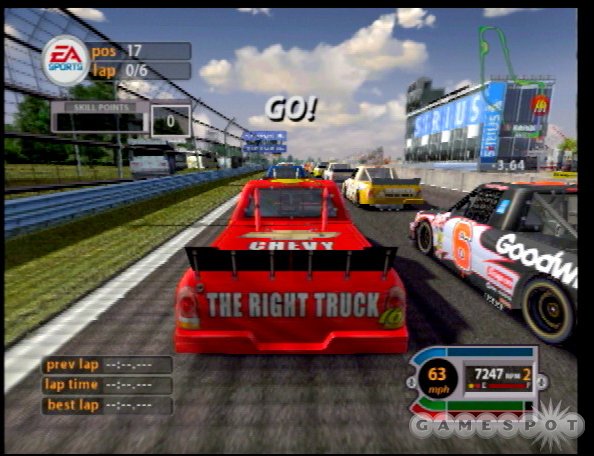
NASCAR 2005: Chase for the Cup has almost everything a NASCAR fan could want. It includes most of the tracks, drivers, cars, and events from the 2004 NASCAR Nextel Cup Series, the Busch Series (called NASCAR National Series in the game), and the Craftsman Truck Series, as well as a basic mock-up of NASCAR's regional Featherlite Modified Series (populated with fictional drivers and sponsors). In all, there are 25 official tracks, 12 fantasy tracks, more than 130 different drivers, and hundreds of different events and paint schemes to pick from.
There are loads of different play options. The race now and season modes let players participate in one race, or they can grind through a full season in any of the different racing series: the chase for the cup mode lets players skip ahead to the final 10 races of the Nextel Cup season; the lightning challenge and Dodge SpeedZone modes let players test their driving skills in a number of actual and fictitious race situations; and there's a career mode, called "fight to the top," which lets players participate in multiple seasons in any or all of the different racing series as both a driver and a team owner. Additional drivers, tracks, paint schemes, and street rides can be unlocked in the career mode. The PlayStation 2 and Xbox versions of the game also include an online mode, which allows up to four players to race against one another in exhibition races.
Perhaps as a nod to the success that the parent company has had with Need for Speed: Underground, EA Sports has added head-to-head road races, street rides, and hip-hop paint schemes to NASCAR 2005. Every so often, in the "fight to the top" mode, a NASCAR pro will challenge you to a head-to-head race on a road course. If you win the race, you'll unlock a new car that can be used in the race now and online race modes. The range of cars that can be won from head-to-head races is decent, and includes the Chevy Corvette, Dodge Viper, Ford Mustang GT, and Ford SVT F-150 Lightning--to name a few.
Oddly enough, some features from NASCAR Thunder 2004 weren't carried over to this year's game. A small number of presentational aspects were curtailed, such as driver introductions and the playing of the national anthem before the race, and for whatever reason, the in-cockpit driving viewpoint was removed as one of the camera options. Offline multiplayer was scaled back--NASCAR 2005 only allows two players to compete simultaneously via a split-screen setup, whereas NASCAR Thunder 2004 allowed up to four players to do so. Support for the EA Sports Bio was removed as well, so you won't be able to use the progress you've made in other EA Sports games during the last two years to unlock some of the game's bonus items. Compared to everything that was added and improved in this year's game, these omissions are merely minor annoyances, but they may be important to some people--especially those of you that have a cluster of buddies that you routinely race against offline.
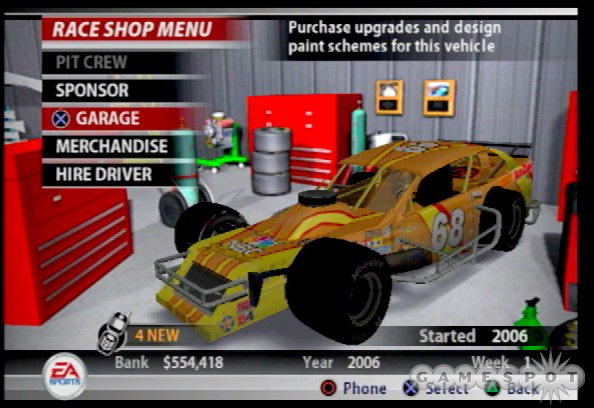
Out of all of the play modes, the "fight to the top" mode is the one that players are most likely to spend the greatest amount of time with. It lets you take a driver through multiple seasons, and it offers many of the same features that the franchise modes in traditional sports games do. You start out as a driver in the Featherlite Modified Series, and your goal is to win races and work your way up through the various NASCAR racing series. Do well in the Featherlite Modified Series and a team will offer you a contract in the Craftsman Truck Series; do well in the Craftsman Truck Series and teams will offer you contracts in the Busch Series, and so on. If you earn enough money, you have the option of buying your own team. As an owner, you'll have control over numerous aspects of the team, including hiring a driver and pit crew, signing sponsorship deals, setting merchandise prices, designing paint schemes and uniform colors, and spending money to train the pit crew or purchase upgrades for the car's engine, suspension, and aerodynamics. The various menus make it easy to manage every aspect of your career: the race shop menu lets you manage all of your various contracts; the events menu provides a calendar of events to enter; the season menu lets you keep track of standings and awards; and the my NASCAR menu lets you spend the skill points you earn on so-called "thunder plates" (which unlock new paint jobs, courses, cars, and drivers for use in all game modes).
The best thing about the "fight to the top" mode is that it lets players choose their own career path. You can stick to one series, move between them, or race in more than one series at a time. You can accept an entry-level contract into another series, or you can choose to accept a more lucrative contract in a lesser series. Once you attract enough fans, the game will periodically ask you if you want to participate in autograph signings--which take the form of a timed button-pushing minigame. You even have control over whether your driver is thought of as a hero or a villain. If you avoid collisions, let other drivers draft, and race cleanly, you'll improve your relationships with specific drivers--attaining hero status. On the other hand, if you bump other cars, cut into other drivers' drafts, and generally race dirty, you'll develop rivalries with the other drivers--attaining villain status. The status you earn will influence how other drivers respond to you out on the track, strengthen your shared drafting or intimidation skills, and contribute to the number of fans that follow your career.
EA Sports introduced draft sharing and rivalries last year. The developers have improved both concepts in this year's game. When you follow along behind another car, the draft meter in the lower right-hand corner of the screen begins to fill up. The fuller it gets, the deeper you are in the opponent's slipstream. In NASCAR Thunder 2004, you could press a button to enable a shared draft when the draft meter was full. This told the opponent you were going to remain in his slipstream in exchange for not rear-ending him or passing too soon, and it usually improved your friendship ratings with the drivers you used it on. The shared draft works the same way in NASCAR 2005, but EA Sports has added a second variation of it, called the intimidator (in honor of #3, the late Dale Earnhardt). When you push the intimidator button, you'll lock onto the opponent's slipstream like normal, only this time you'll send a signal to the other driver that tells him that you intend to do whatever is necessary to move up another spot. In some cases, the driver up ahead will become so rattled that he'll move out of your way or lose control of his car. The shared draft and intimidation concepts certainly aren't grounded in reality, but they do help the game reproduce the alliances and rivalries that form during the actual sport's racing season.
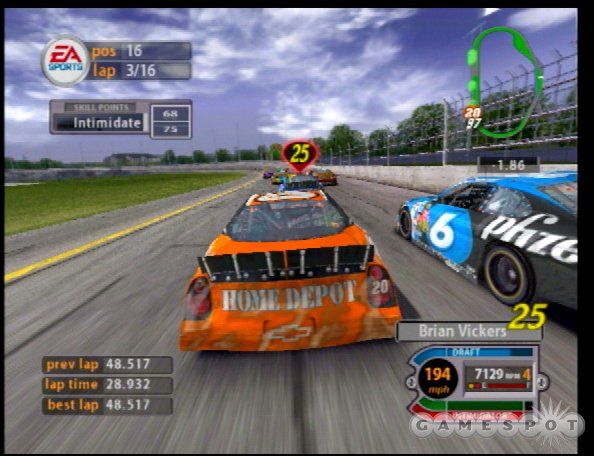
Rivalries work pretty much the same way in NASCAR 2005 like they did in NASCAR Thunder 2004, in that good driving and use of the shared drafting button will build alliances with other drivers, while reckless driving and use of the intimidation button will create rivalries. Allies will leave you alone on the track or they will get out of the way when you try to pass. Rivals will try to block your pass attempts and will often slam into you as retaliation for pass transgressions. EA Sports has refined the rivalry concept this year by making it so rivalries and alliances fade more quickly between races, and so that the shared draft and intimidation features have a much faster impact on your relationship with other drivers.
Rivalries and drafting certainly are integral facets of NASCAR, but they wouldn't matter a hill of beans in a video game unless the artificial intelligence, controls, car physics, and car setup options also lived up to the standards set by the real sport. NASCAR 2005 sets the bar high with regard to AI, controls, and car handling, and it earns a passing nod with regard to car physics and car setup options.
The AI-controlled drivers in NASCAR 2005 will form into packs to set a pecking order, and they will sometimes make mistakes that can cause them to fall back a few spots or result in spectacular wrecks--just like actual NASCAR drivers do. The frequency of wrecks in NASCAR 2005 has been scaled back compared to NASCAR Thunder 2004. You'll see two or three wrecks per race now instead of the half-dozen or more that happened in every race in last year's game, which feels about right. AI drivers will draft when they're off the pace, cut in front when other drivers try to pass, and help out teammates by blocking or nudging other cars out of the way. You can adjust the AI drivers' skill level to one of three different settings in the settings menu that appears before each race.
The controls are intuitive and the overall car handling feels reasonably realistic. Steering is done with the left analog stick, acceleration and braking are handled with the right analog stick (or, alternatively, with two controller buttons), and, if you activate the manual transmission option, you can upshift and downshift using the left and right trigger buttons. Pit stops are enabled by default on advanced difficulty settings and the implementation is pretty no nonsense. When you drive into the pit area, a menu pops up that lets you choose how many tires to replace, whether to repair damage to the car, how much fuel to add, and any adjustments you want the crew to make to the car's wedge angle and tire pressure. The various options contribute to how much time a pit stop will take, which means you can choose to change only two tires or just add a little extra fuel in order to get out of the pits sooner. Much like what happens in an actual race, one of the best pitting strategies is to go in under a caution flag so that you don't drop any spots in the order.
The way vehicles react to how you drive depends on the type of vehicle you're driving. Featherlites have wider wheel footprints, so they're less prone to skids than trucks, which tend to have slippery rear ends and spin when nudged. Busch and Nextel Cup-level cars are extremely stable when you stick to a safe line, but they'll swerve and spin out if you shake the wheel too much or drive onto the track apron. Things like fuel quantity, tire wear, and damage also influence the overall handling of the car. These options, along with stability control and braking assists, can be turned on or off in the settings menu.
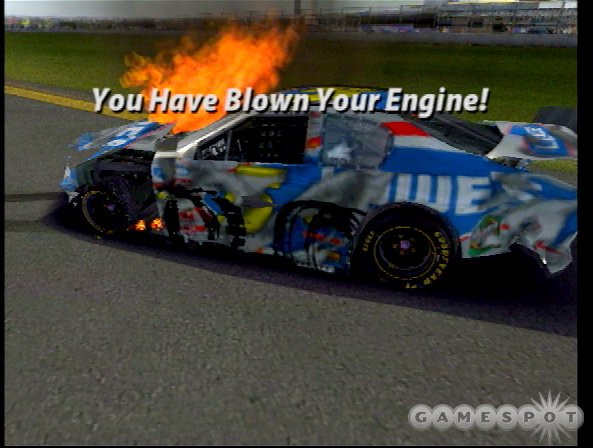
Most players will be satisfied with the game's physics and with the available range of car setup options. Bumping into other cars or the walls will cause you to lose some degree of control over the car, and you're liable to skid or spin out if you yank the wheel from side to side repeatedly. Drafting behind other cars will give the car a slight speed boost, while skidding through a turn will slow the car down. If you spin out in the middle of the pack or slam into a wall, a pileup may occur and you may end up blowing out your engine or fuel tank (if you have damage enabled). That's all fairly realistic, but, for some reason, the game is very forgiving when it comes to minor scrapes and "gentle" collisions. You can nudge other cars or race along without experiencing much in the way of consequences with regard to the car's handling or structural integrity.
As for tuning the car, you can bring up a setup menu during practice, happy-hour runs, and right before an actual race, which allows you to tweak four major aspects of the car's handling--including tire pressure, downforce, suspension, and gear ratio. The gear ratio menu is the most hands-on of the four. It lets you pick from nine different presets or it lets you configure your own custom ratio by adjusting each gear individually. The other tuning adjustments have two or three available options each. The number of available handling adjustments is more than sufficient, but the absence of some expert settings, such as weight, camber, and shocks, may bug players that cut their teeth on games like Atari's NASCAR: Dirt to Daytona or Papyrus' NASCAR Racing series for the PC.
One area that's tough to find fault with is the game's visuals. The graphics are sharp, the 3D car models are realistic, and the textures have been stored at such a high resolution that you can clearly read advertisements, slogans, and sponsor logos from a variety of distances and angles. Every official NASCAR driver has the same car, paint job, and sponsor decals he carries during the season, and there are dozens of custom paint schemes to pick from as well. Cars show visible signs of wear and damage as the race goes on. The courses have every fence, flag post, building, Jumbotron screen, and grandstand that they have in the real world. These details aren't static either--flags blow in the wind, stadium displays show race viewpoints, and the clouds in the sky are reflected at different angles in the windows of buildings as you pass by. The draw-in distance is exceptional. Courses are surrounded by hills, mountains, and cities--not bitmaps, but fully rendered 3D objects--and structures on the other side of the track don't just pop into view like they do in some games. The sheer variety of different details visible in each course environment is also extremely sick. Tire tread is left on the track when cars skid, paint sticks to the wall when cars scrape alongside it, and clouds of exhaust and smoke are left behind when cars spin out or crash. If you stop the car in front of the grandstands, you can make out individual spectators. The sponsorship banners that line the track come from actual businesses, such as Coca-Cola, Subway, Lowe's, and Napa Auto Parts. The game even randomly generates the amount of sunlight and cloud cover that's visible in the sky for each race.
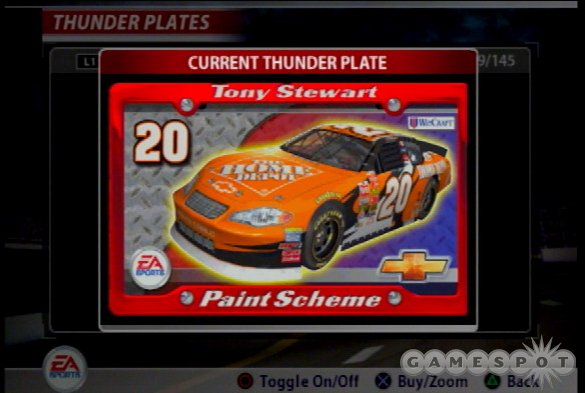
Despite the abundance of detail, the graphics engine manages to maintain a steady 60 frames per second most of the time, which keeps the action silky smooth and helps contribute to the game's overall sense of speed. The game does drop a frame here and there, especially on complicated road courses; but even when the frame rate does stutter, the resulting choppiness only lasts for the briefest of moments. It's tough to call the game on a few choppy moments when the graphics engine has the immense job of rendering 43 individual cars, a litany of visual effects, and everything else out on the course all at once.
Most of the audio you'll hear during a race comes from the sounds the cars make as they move down the track and from your pit crew radio. The sounds made by car engines, screeching tires, and scraping metal all seem pretty lifelike. Different sounds vary in volume and location in relation to your car's position among them. The pit crew radio is much more active this year--the crew chief provides a wider variety of information about the car's status and gives immediate warnings when an opponent makes a move to pass. The crew also chimes in with a large vocabulary of compliments and insults regarding your split times, driving ability, and events that happen out on the track. Sadly, the pre- and postgame wrap-ups that injected so much charm into last year's game aren't present in NASCAR 2005, but the improved crew radio is worth the trade-off. If you don't want to listen to the pit crew, you can listen to the car's radio instead. The soundtrack includes 18 different tracks from popular artists such as Saliva, Papa Roach, and Foghat.
NASCAR 2005 is available for all three major consoles--the PlayStation 2, Xbox, and GameCube. All three games look, sound, and play very similarly to one another. The shared draft and intimidation buttons feel more intuitive mapped to the L2 and R2 buttons on the PlayStation 2 controller, but their positions on the auxiliary buttons on top of the GameCube and Xbox controllers don't cause any noticeable discomfort. Even though the Xbox and GameCube theoretically have more graphical horsepower than the PlayStation 2, the two systems still experience the same frame-rate inconsistencies that the PS2 does. All three versions support 480p progressive scan displays. The Xbox version has in-game Dolby Digital 5.1 audio, which makes that version best for those with high-end 5.1 audio setups; but the PS2 and GameCube versions also offer surround-sound support, albeit in the form of Dolby Pro-Logic II. The one feature that the GameCube version doesn't have, that the other two do, is online play. Both the PS2 and Xbox games let players log on and participate in races involving up to four human drivers (along with a full pack of CPU drivers).
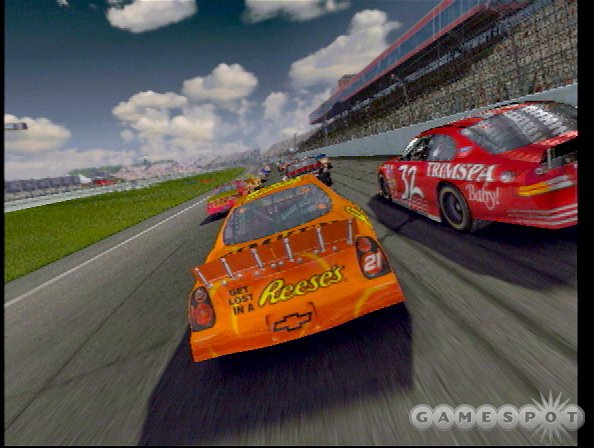
The game's online options are sufficient, but they don't really make use of all of the features that Sony's or Microsoft's online services are capable of. Other racing games with online support allow anywhere from 8 to 16 people to compete against one another, while NASCAR 2005 limits the field to a maximum of four human players. A field of up to 40 AI-controlled drivers can be enabled to fill up the track. Both versions of the game support voice chat, friends lists, password-protected games, and a system of leaderboards to keep track of a variety of statistics. However, the process of joining and rejoining games is rather cumbersome. Once a race ends, the game boots players back out to the main network lobby instead of back to one of the chat or game rooms. That makes it difficult to run repeat races with the same group of people, since everyone has to relocate everyone else and the host has to set up a new race from scratch. On the upside, races never really hiccup unless you play against someone with an extremely bad connection. The PlayStation 2 version also supports dial-up connections in addition to broadband connections. However, dial-up users tend to experience quite a bit of lag, which can be eased somewhat by reducing the number of AI-controlled cars or by playing head-to-head instead of with four players.
Ultimately, no matter which console you own, if you're a NASCAR fan you simply must go out and pick up NASCAR 2005: Chase for the Cup. It re-creates the NASCAR experience in spectacular fashion, and all of the included modes, series options, and extras provide an excellent amount of value for the cost. Despite the removal of a few features that made NASCAR Thunder 2004 seem so complete, EA Sports has trumped that release by including so many new features in this year's game.